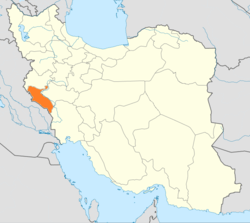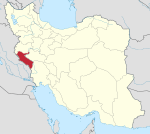Ilam Province
| Ilam Province Ostān-e Īlām | |
|---|---|
| Province | |
 Location of Ilam within Iran | |
| Coordinates: 33°38′18″N 46°25′21″E / 33.6384°N 46.4226°ECoordinates: 33°38′18″N 46°25′21″E / 33.6384°N 46.4226°E | |
| Country |
|
| Region | Region 4 |
| Capital | Ilam |
| Counties | 8 |
| Area | |
| • Total | 20,133 km2 (7,773 sq mi) |
| Population (2011)[1] | |
| • Total | 557,599 |
| • Density | 28/km2 (72/sq mi) |
| Time zone | IRST (UTC+03:30) |
| • Summer (DST) | IRST (UTC+04:30) |
| Main language(s) |
Persian (official) local languages: Kurdish Lurish Arabic |
Ilam Province (Persian: استان ایلام,Kurdish: Provinsa Îlam) is one of the 31 provinces of Iran. In 2014 it was placed in Region 4.[2] It is in the west of the country, bordering Iraq. Its provincial center is the city of Ilam. Covering an area of 19,086 square kilometers, the cities of the province are Ilam, Mehran, Dehloran, Dareh Shahr, Sarable, Eyvan, Abdanan and Arkwaz. It neighbors Khuzestan province in the south, Lurestan province in the east, Kermanshah province in the north and Iraq in the west with 425 kilometers of common border. The population of the province is approximately 550,000 people (2011 estimate).
Geography
Ilam province is among the warmest regions of Iran, although the mountainous areas of north and north eastern Ilam are relatively cold. The average annual rainfall province is 578 mm. Ilam's highest point is the peak Kabir Kuh at 3200 m, part of the Zagros mountains. Eyvan and Ilam (city) are less warm than the other cities in the province because they are situated in the north of the province. Wheat is the most common crop cultivated in this province.
In 1996, the absolute maximum temperature was 38 °C in August and the minimum temperature was 0.4 °C in February. The number of freezing days in winter was 27 days.
People and culture
The population of Ilam City is predominantly Feyli Kurds. The absolute majority of the residents in the southern part of the province (Abdanan, Darreshahr, Badreh, Dehloran and Mehran) are Kurds and speak Kurdish.[3] There are also some tribes of Lurs (absolute minority) who live mostly in the southern and eastern parts of the province. So, in the southern part of the province, the main ethnicities are Kurds, Laks and Lurs respectively. The north is mostly inhabited by Kurdish tribes who speak two dialects: Kalhuri and Feyli.[3] The majority are Feyli, such as those of Khezel, Arkawâzi, Beyrey (Ali Sherwan), Malek shahi and Shuhan.[4] [3] Most are Shi'a Muslims.[4]
Counties

History
Limited archaeological studies and discoveries indicate 6,000 years of tribal residence in Ilam. Historical evidence indicates that Ilam province was part of the ancient Elamite Empire. In some of the epigraphs left from Sumerian history, this territory was called Alam, Alamo, or Alamto meaning the high lands where the sun rises.
It was also part of the Achaemenid Empire. Existence of numerous historical vestiges in Lurestan and Ilam provinces belonging to the Sassanid period indicates the specific importance of the region in that time. In this period Ilam province was divided into two regions, Mehrjankadak in the eastern part and Mâsabazân at the western part.
Kurdish tribes governed the region from the late 11th century till the early 13th century.
In the 1930 division of Iran, Ilam became a part of Lorestan province, Kermanshah and Khuzestanprovince province, only later to become a province by itself. Ilam is still a tribal province in many ways, but in recent years the tribal relations have changed drastically.
Ilam today
During the Iran-Iraq war, Ilam province suffered heavily and Iraq's intense bombings left no economic infrastructure for the province. Ilam thus remains one of Iran's more undeveloped provinces. Ilam's unemployment rate was 19.9% in 2003.
Only in recent years has the central government began investing in advanced industries like Petrochemical facilities, with Japanese help, in Ilam. Ilam also has a bright future in the tourist sector, with 174 historical sites listed under Iran's Cultural Heritage Organization, though it also remains undeveloped.
Colleges and universities
Ilam province contains the following universities:
- Ilam University of Medical Sciences
- University of Ilamhttp://ilam.ac.ir/
- Islamic Azad University of Ilam
- Payame noor University of Ilam
Attractions
- Imamzadehs: These are shrines mostly from the Middle Ages: Imamzadeh Ali Saleh, Imamzadeh Seyd mammad Abed, Imamzadeh Seyd Akbar, Imamzadeh Seyd Fakhreddin, Imamzadeh Seyd Nasereddin, Imamzadeh Ibrahim, Imamzadeh Abbas, Imamzadeh Abdullah, Imamzadeh Pir Muhammad, Imamzadeh Baba Seifuddin, Imamzadeh Mehdi Saleh, Imamzadeh Ibrahim Qetal, Imamzadeh Seyd Hasan, Imamzadeh Seyd Salaheddin Muhammad, Imamzadeh Haji Bakhtiar, Imamzadeh Haji Hazer, Imamzadeh Jabir.
- Fire Temples (10 in total): These are Zoroastrian shrines from the Sassanid era, now in ruins: Siyahgol Iwan, Chahar Taghi in Darreh Shahr.
- Mansions, forts, and castles (90 in total): Ghal'eh Vali (Qajar era), Posht Ghal'eh Chowar, Ghal'eh Paghela Chekarbuli, Ghal'eh Falahati (Qajar era),Ghal'eh Ghiran (Achaemenid era), Shiagh castle in Dehloran (Sassanid era), Ismail Khan fort, Sam castle (late Parthian era), Pur Ashraf castle, Mir Gholam Hashemi ghal'eh, Posht Ghal'eh Abdanan (Sassanid), Konjancham fort, Shirin and Farhad Iwan in Mehran (Parthian era), Hezar Dar Castle (Sassanid), Sheikh Makan Fort (Sassanid), Zeinal Fort.
- Bridges from Sassanid era (5 in total).
- Numerous archeological sites (Teppes) and ruins from Sassanid era and earlier (224 in total).
- Ancient reliefs scattered across the province (8 in total).
- Ancient urban settlement ruins (22 in total).
- Springs, caves (like the cave of Zinegan), 3 protected natural habitats, and provincial parks.
- Tar Spring, in Dehloran.
Tar Spring, Dragon Blood
One of the most interesting things to be found near the city Dehloran is a natural liquid tar spring.[5] Iranians used to use this tar to render ships and roofs waterproof about 3000 years ago. This black spring is located in a natural protected area named Abgarm. Interesting things around this area include mineral water springs, native trees, and bat caves with rare species of bats.
The road to the Black Spring is near city Dehloran and leads to the Abgarm natural protected area. A sign guides visitors to the spring via a narrow road. The last few hundred meters of the road is not suitable for vehicles and requires a short walk to reach to the spring. Visitors will notice the smell of tar as they approach. The spring’s diameter is about 9 meters and hot water full of liquid tar particles flows out of it. There is a fence to protect animals from going nearby and get trapped in the tar.
According to myths told by the native people, this tar spring was the blood of a dragon that was killed by the Iranian hero, Esfandiar.[5]
See also
- Elam
- Ethnic minorities in Iran
- Feyli Kurds
- Southern Kurdish
References
- ↑ Selected Findings of National Population and Housing Census 2011
- ↑ "همشهری آنلاین-استانهای کشور به ۵ منطقه تقسیم شدند (Provinces were divided into 5 regions)". Hamshahri Online (in Persian). 22 June 2014. Archived from the original on 23 June 2014.
- ↑ 3.0 3.1 3.2 "An Error Occurred Setting Your User Cookie".
- ↑ 4.0 4.1 LookLex Encyclopaedia, retrieved 1 February 2008
- ↑ 5.0 5.1 "Ilam". ilam.rmto.ir. Retrieved 26 June 2013.
External links
| Wikimedia Commons has media related to Ilam Province. |
- (Persian) Ilam Province Department of Education
- (Persian) Ilam Picture Gallery
- Hamid-Reza Hosseini, Shush at the foot of Louvre (Shush dar dāman-e Louvre), in Persian, jadidonline.com, 10 March 2009.
Audio slideshow (6 min 31 sec). - "Images and photos Dehloran - Ilam Ostan". viewphotos.org.
 |
|
Kermanshah Province |  | |
| style="width:33% rowspan=3 | |
|
Lorestan Province | ||
| ||||
| | ||||
| |
Khuzestan Province |
| |||||||||||||||||||||||||||||||||||||||||||||||||||||||
